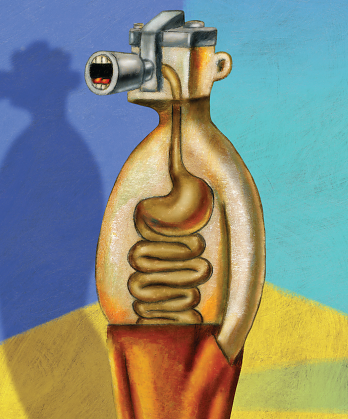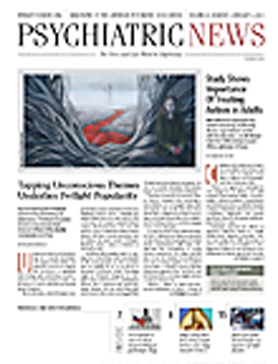Criteria for “binge eating disorder,” the fruit of an explosion of research on the subject since publication of DSM-IV, are being proposed for inclusion in DSM-5. The addition of the disorder, defined as recurrent eating of “an amount of food that is definitely larger than most people would eat in a similar period of time under similar circumstances,” is among the major changes proposed for the chapter on feeding and eating disorders. Virtually identical criteria for binge eating disorder were listed in the appendix to the chapter in DSM-IV but it was not included as an official diagnosis.
“In the 20 years since publication of DSM-IV, there have been more than 1,000 papers published on binge eating disorder,” Timothy Walsh, M.D., chair of the Feeding and Eating Disorders Work Group for DSM-5, told Psychiatric News. “We now have an extraordinary amount of data that have really provided a strong basis for arguing that this is an appropriate disorder to include in the diagnostic manual.”
As with all proposed changes to the manual, the work group’s proposed criteria are undergoing field trials and will be extensively reviewed by the DSM-5 Task Force and APA’s Scientific Advisory Board before the manual is published in 2013.
In addition to describing a cohort of patients who experience significant distress in relation to overeating, inclusion of the criteria is also designed to reduce the number of eating-disorder patients who are classified using the “NOS”—not otherwise specified—designation.
As in other areas of psychiatric diagnosis, at the time DSM-IV was developed the lack of research to support more specific diagnoses has resulted in overuse of NOS to designate eating-disorder patients who do not adequately fit existing DSM-IV criteria; the enormous body of research now available on binge eating has made possible the inclusion of a diagnostic category specific to the disorder.
According to the proposed criteria, the disorder is marked by “a sense of lack of control over eating during the episode” associated with three or more of the following:
eating much more rapidly than normal,
eating until feeling uncomfortably full,
eating large amounts of food when not feeling physically hungry,
eating alone because of feeling embarrassed by how much one is eating, and/or
feeling disgusted with oneself, depressed, or very guilty afterward.
The binge eating occurs, on average, at least once a week for three months and is not associated with the recurrent use of inappropriate compensatory behavior (such as purging) and does not occur exclusively during the course of other eating disorders.
Walsh refutes critics who claim the criteria do not adequately distinguish pathological behavior from the kind of periodic overeating in which many people indulge. “That simply isn’t true— the disorder is really a phenomenon of frequently eating an abnormal amount combined with feelings of shame, guilt, or disgust. The behavior is recurrent, and it feels wrong. It’s that combination of factors that distinguish it from the overeating that we all occasionally do.”
He said epidemiological studies by James Hudson, M.D., of Harvard University School of Medicine indicate a lifetime prevalence of the disorder of 4 percent to 5 percent. Cognitive-behavioral therapy and interpersonal psychotherapy, as well as antidepressant medication, appear to be effective, Walsh said.
Also proposed is addition of criteria for avoidant/restrictive food intake disorder (ARFID), a category intended to capture children—and some adults— who have idiosyncratic requirements regarding food, such as eating only food of a certain texture or color. The behavior is associated with failure to meet energy or nutritional needs as exemplified by one or more of the following:
significant weight loss (or failure to gain weight or faltering growth in children),
significant nutritional deficiency, dependence on enteral feeding, and/or marked interference with psychosocial functioning.
“The criteria make clear this is not the very frequent food-related idiosyncrasies kids develop normally,” Walsh said. “Such normal variations do not lead to weight loss, require nutritional interventions, or result in severe psychosocial impairments. The diagnosis is not made unless there is a clear, clinically significant need for intervention.”
The criteria define the disorder as an “eating or feeding disturbance that includes, but is not limited to, apparent lack of interest in eating, avoidance based on the sensory characteristics of food, or concern about aversive consequences of eating that results in persistent failure to meet appropriate nutritional and/or energy needs.”
Walsh said criteria for ARFID would also encompass cases in which, for example, a child has an episode of choking or vomiting that is so frightening or upsetting that the child’s solution is to stop eating. “These kids don’t have anorexia or bulimia, but they are showing up for treatment,” he said.
But Walsh acknowledged that ARFID is a new condition for which data are only now emerging. “Whether there will be sufficient data available in the next 12 months to allow it to be officially recognized is an open question,” he said. “We are convinced it should be, and that’s our recommendation to the task force.”
For anorexia nervosa, the work group is proposing some editorial changes to existing criteria related to body weight and “fear of getting fat” (see Proposed Changes to Criteria for Feeding and Eating Disorders). Walsh said there are patients who meet all criteria for anorexia nervosa but do not acknowledge a fear of getting fat; the newly proposed criteria read as follows: “Intense fear of gaining weight or becoming fat or persistent behavior that interferes with weight gain, even though at a significantly low weight.”
But the most significant change to criteria for anorexia nervosa is the elimination of amenorrhea as a requirement for diagnosis. “A literature review yielded a body of research showing that women who meet all the criteria for anorexia nervosa but still report some menstrual activity are virtually identical in terms of clinical impairment and treatment response,” Walsh told Psychiatric News. Other proposed changes for feeding/eating disorders are relatively minor. For bulimia, criteria describing frequency of binging/purging episodes were changed from twice a week for three months (as in DSM-IV) to once a month for three months.
Walsh said the change may seem large, but data from several sources indicate that the number of cases receiving a diagnosis of bulimia nervosa in clinics where such patients are seen increases only minimally using the new criteria.
“This suggests that it is uncommon for someone who engages in such behaviors to do so only once a week,” he said. “Actually, in clinical samples, the average frequency of binge eating and purging is five to 10 times per week.”
Other changes in the eating disorders chapter include the addition of some disorders—pica and ruminative eating disorder—that had previously been classified under “Disorders of Childhood and Adolescence.”
More information on feeding and eating disorders in DSM-5 is posted at www.dsm5.org/ProposedRevision/Pages/Feeding andEatingDisorders.aspx .
Proposed Changes to Criteria for Feeding and Eating Disorders
Addition of Binge Eating Disorder
1.
Criteria include frequent overeating—at least once a week for three months— combined with lack of control, marked feelings of distress, and are associated with three or more of the following:
1.
eating much more rapidly than normal
2.
eating until feeling uncomfortably full
3.
eating large amounts of food when not feeling physically hungry
4.
eating alone because of feeling embarrassed by how much one is eating
5.
feeling disgusted with oneself, depressed, or very guilty afterward
Addition of Avoidant/Restrictive Food Intake Disorder
Defined as an “eating or feeding disturbance (including but not limited to apparent lack of interest in eating or food, avoidance based on the sensory characteristics of food, or concern about aversive consequences of eating), as manifested by persistent failure to meet appropriate nutritional and/or energy needs.
Anorexia Nervosa
1.
Elimination of amenorrhea as a requirement for diagnosis
2.
Clarification of criteria related to body weight:
1.
Elimination of the words “refusal to maintain minimal body weight” to be replaced by the following: “Restriction of energy intake relative to requirements leading to a significantly low body weight in the context of age, sex, developmental trajectory, and physical health.”
2.
Significantly low weight is defined as a weight that is less than minimally normal, or for children and adolescents, less than that minimally expected.
3.
Clarification of criteria related to “fear” of becoming fat to account for patients who do not admit to such fear. The newly proposed criteria read as follows: “Intense fear of gaining weight or becoming fat or persistent behavior that interferes with weight gain, even though at a significantly low weight.”
Bulimia
Criteria for frequency of bulimic episodes changed from twice a week for three months (as in DSM-IV) to once a month for three months.
Incorporation of Disorders Now Listed Elsewhere in DSM-IV
Pica and rumination disorder, formerly included in disorders of childhood and adolescence, are proposed for inclusion under the chapter on feeding and eating disorders.


